A City Full of Natural Beauty and Historic Sites
Audio Guide for 12 Select Spots in "Arashiyama · Sagano" Area
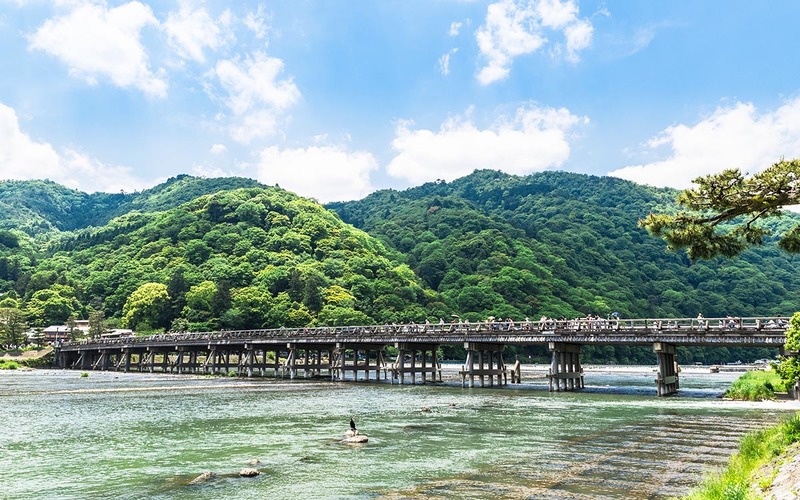
Exploring the Arashiyama/Sagano Area
One of the most famous sightseeing places in Kyoto is the Arashiyama and Sagano area. Here you’ll find scores of shrines, temples and gardens where you can enjoy the changing of seasons from cherry blossoms and green foliage to autumn colors. The breathtaking landscape was favored by the emperor and his court during the Heian period, a time when the area was also a popular hunting destination. A tour of the area will easily take you to many well-known temples and shrines such as World Heritage Site Tenryu-Ji, Nonomiya Shrine of “Tales of Genji” fame, and Rakushisha and Nison-In Temple just to name a few. You can also add a little adventure to your sightseeing with a boat ride on the Hozugawa River or a trolley train ride along the banks of the river.
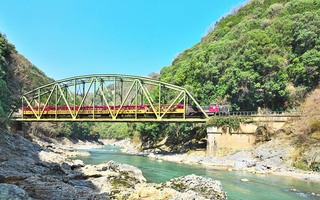
A Sagano Romantic Train
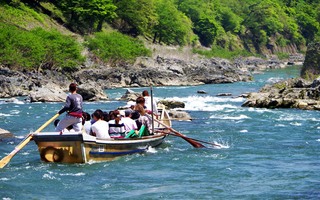
B Hozu-Gawa-Kudari /Hozugawa River Boat Ride
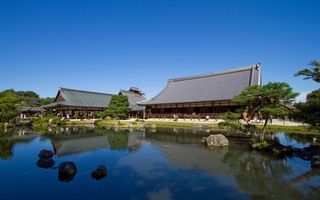
C Tenryu-Ji Temple
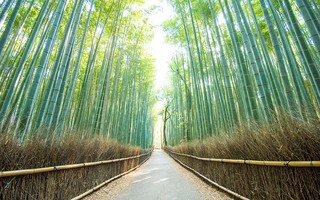
D Arashiyama Bamboo Grove
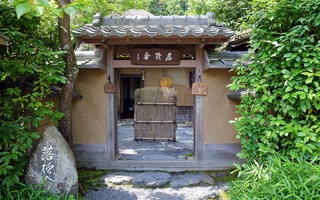
E Rakushisha
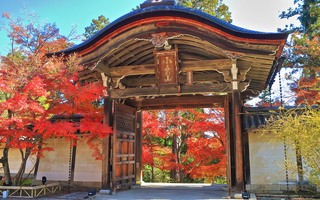
F Nison-In Temple
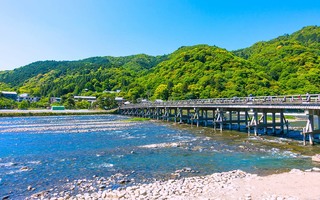
G Togetsukyo Bridge
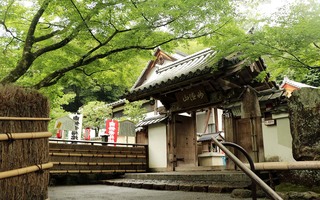
H Mt. Miyoutoku Kegon-Ji Temple (Suzumushi-Dera Temple)
A
Sagano Romantic Train

The Sagano Romantic Train connecting Arashiyama and Sagano with Kyoto Kameoka was launched by the Sagano Tourist Railway in 1990 using the discontinued JR San-in Line. In order to enjoy the beautiful scenery along the Hozugawa River, locals swapped out rusted rails and rotten sleepers, reinforced the collapsed rail shoulder, and planted seedlings of cherry and maple trees around the tracks. Many striking rock formations and large boulders can be spotted along the banks of the Hozugawa River, which flows at the bottom of the railroad’s steep slope. On both banks of the Hozugawa River, there are mountains full of cherry blossoms to be enjoyed in springtime and Yamazatoji trees that appear to be ablaze in the fall. All of this gorgeous natural scenery, even the rapids splashing the rocks, can be enjoyed in panorama from the train window. On a nice day, we recommend you climb aboard car No. 5 "The rich", which has a open-air deck without windows, and take in the fresh mountain air on your journey through the ravine.
B
Hozu-Gawa-Kudari /Hozugawa River Boat Ride

The upper course of the Oigawa River flowing through Arashiyama is called the Hozugawa River. In the 1600s, the waterway for transporting goods was renovated by the wealthy merchant Suminokura Ryoi. Because the Hozugawa River was littered with boulders, smaller rocks were hoisted over and then dropped on to these boulders, smashing them up and, thereby, securing the waterway. This is how the Hozugawa River became indispensable in transporting goods to Kyoto and Osaka.
The landscape around Hozukyo Gorge is so captivating that the "Hozugawa Kudari," meaning Hozugawa River boat ride, began for sightseeing purposes in the middle of the Meiji era. Running 16 kilometers from Kameoka to Arashiyama, Hozugawa Kudari is the longest river boat ride in Japan and has been awarded a star on the Michelin · Green Guide. The flow of the river differs depending on the weather and the water level. When the water level is high, the boat zips down the river at a thrilling pace for about 90 minutes. When the water level is low, the ride becomes a gentle 2-hour cruise.
Cherry blossoms in the spring are a sight to behold here, but there are also the singing of Kajika frogs in the summer and harvest colored leaves in the fall to enjoy. In the winter, special boats retrofitted with heated tatami rooms are available for a cozy ride through the riverscape.
C
Tenryu-Ji Temple

"Tenryu-Ji Temple" is the head temple of its own sect of Rinzai Zen Buddhism. It was founded by Ashikaga Takauji in 1339 in memory of Emperor Go-Daigo. Ashikaga Takauji and Emperor Kogen Jyoukou donated a manor at the time of construction. That, however, was not enough, and they decided to resume trade with the "Gen-ko,” which had requested independence from the Mongol empire at the time. This is said to be how the building of Tenryu-Ji Temple boats began and with the profit the temple turned from the trade, they were able afford the landscaping expenses. As a result, for a long time, Tenryu-Ji Temple prospered as the leading temple within Kyoto's Five Mountains, but after that, the temple has been repeatedly rebuilt due to fires and wars. Sogenchi Teien garden that`s within the premises is a magnificent garden that still bears its original appearance. It is accredited as a national historic site and is considered an iconic scenic spot. It is recognized for its historical and cultural value and was designated a World Heritage Site in 1994 in the list of "Historic Monuments of Ancient Kyoto."
D
Arashiyama Bamboo Grove

Arashiyama Bamboo Grove is a famous tourist destination at Arashiyama connecting Nonomiya Shrine all the way up to Okouchi-Sanso. There are many bamboo groves in the Sagano area, which is a place known for its tranquility and natural beauty and where residences and cabins for the nobles during the Heian period were built. The lush bamboo forests here stand tall, as if they could reach the sky, with sunlight seeping in between the leaves. A stroll through a walkway by a fence of brushwood is enough to breathe new life into you. In 1996, it was chosen by the Ministry of Environment as one of 100 scenery spots in Japan that need to be preserved. At the annual Arashiyama Hanatouro festival held in early winter, the walkway of the bamboo grove is illuminated at night for tourists to meander through this beautiful and mystic arrangement. It is also frequently seen in TV dramas, movies and commercials.
E
Rakushisha

Rakushisha was built around 1685 as a second house for the haiku poet Mukai Kyorai, who was a student of the famous Matsuo Basho. Rakushisha, meaning "falling persimmon fruit" in Japanese, is said to be named for the fruit of the 40 persimmon trees in the garden that fell overnight. Kyorai’s famous teacher actually visited and stayed three times at the residence as the two were quite close. This place is also well-documented in his teacher’s journal, "The Saga Diary (Saga nikki)." Also on site are exhibits of 13 haiku written by Gatori and Kyorai and as well as sayings of Takahama Kyoshi engraved in a stone monument. The straw-thatched roof of this building evokes the peace and tranquility of the past. Try imagining what Kyorai’s life was like and you may feel inspired to write a haiku yourself here to submit to the seasonal magazine “Rakushisha.” If your haiku is selected, not only will it be published in the magazine, but a copy of the issue will also be sent to you.
F
Nison-In Temple

In the Heian period between 834 and 847 AD, Nison-in Temple was opened by the Chief Tendaijashu priest "Jikaku Daishi Ennin.” The official name for this temple is Ogurayama Nison-in Kadaiji temple. During the violent period that occurred from 1467 to 1477, the temple was ravaged by the war and was rebuilt by a disciple of the monk "Hounen Shounin.” The temple was built at the foot of Mt. Ogurayama, which is the subject of renowned song "Ogura Hyakunin Ishu”, a beautiful scenic spot known for its fall colors. Nison-in, meaning “two Buddhist teachings,” houses two wooden Buddhist statues: the Tathagata statue, "Shaka Nyorai" and the Amitabha statue, "Amida Nyorai" as well as other important cultural artifacts, like the color paintings on silk, "Kenpon Chakushou You-In Sanetaka" and "Shou Myou-In-Kin Eda.” After entering the elegant gates of Nison-in, you will see a large walkway that stretches over 200 meters, flanked by the Japanese Momiji maple trees on both sides. This path is called the "Momiji-no-baba.” During autumn, the color contrast of bright red leaves, Karamon gate, tsukiji fence and the white walls of the main hall is absolutely splendid, a blanket of red and yellow leaves covering every district.
G
Togetsukyo Bridge

The Togetsukyo bridge over the Oigawa River in Arashiyama divides the river into two; the upper course is called the Hozugawa-River and the lower course is called the Katsuragawa River. The original bridge was built between 834 to 848 AD by a monk named Dosho. The bridge you see now at this current location, however, was built by Suminokura Ryoi, who was a wealthy merchant in the 1600s. He is credited with improving the waterways of the Hozugawa River and thus, greatly profiting from it. The bridge was named Togetsukyo, or "crossing moon.” The Emperor Kameyama is said to have been looking at the moon slowing moving over the bridge and musing, "It resembles the moon crossing into darkness.” The current bridge was completed in 1934 and although the pier and the supports are reinforced by concrete, part of the railing is made of wood so as to harmonize with the Kyoto scenery. Many tourist pamphlets about Kyoto and Arashiyama feature photographs of this bridge, as it is a symbol of the Arashiyama landscape.
H
Mt. Miyoutoku Kegon-Ji Temple (Suzumushi-Dera Temple)

Within the main hall of the Suzumushi-Dera Temple, the sound of "suzumushi,” or bell crickets, echoes throughout the year. The official name of this temple is Myoutokuzan Kegon-Ji Temple and it was opened in 1723 by the eminent monk Houtan Shounin. Houtan studied countless Buddhist texts from many temples in Kyoto and Osaka, completing his studies at the Kegon sect in Nara. He then shared the teachings of the Kegon sect with many people in an easy-to-understand manner. In 1868, the Kegon-Ji Temple was converted to the Rinzai sect. The name Suzumushi-Dera temple derives from the tale of a monk who opened up to Zen by listening to the crickets. After enlightenment, he could hear the singing of the suzumushi irrespective of the season. There are always more than 10,000 suzumushi bred to live inside the main hall, where you can hear the beautiful singing. Those who come to pray at Suzumushi-Dera Temple are ushered through to the main hall and while listening to the chirping of crickets, tea and sweets are provided as a monk tells you stories about the suzumushi. Moreover, standing at the mountain gate of Suzumushi-Dera Temple is a Koufuku Jizou-San, a Jizo statue of happiness wearing straw sandals. It is widely believed that if you pray to the statue, your wish will come true, and now people from all over the country come to pay their respects.